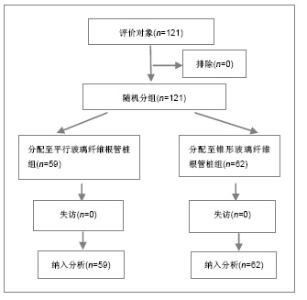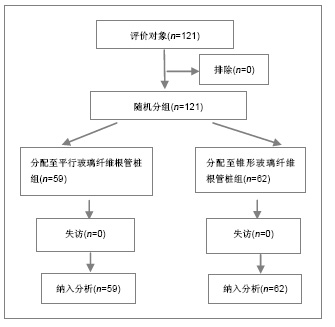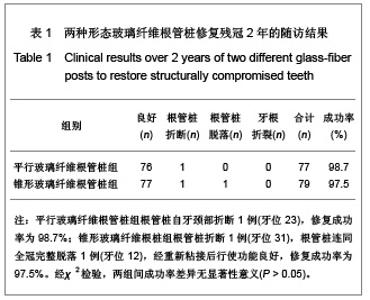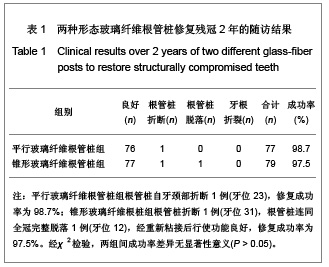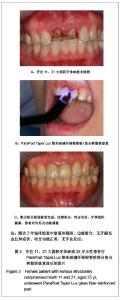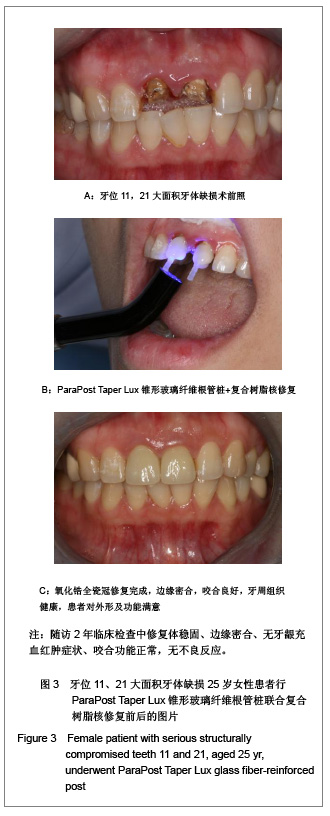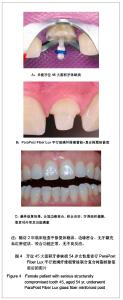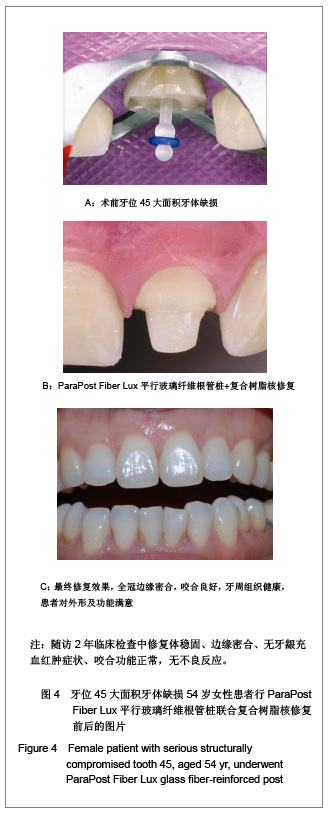| [1] Souza EM,do Nascimento LM,Maia Filho EM,et al.The impact of post preparation on the residual dentin thickness of maxillary molars.J Prosthet Dent.2011; 106(3): 184-190.[2] Mangold JT, Kern M.Influence of glass-fiber posts on the fracture resistance and failure pattern of endodontically treated premolars with varying substance loss: an in vitro study.J Prosthet Dent.2011; 105(6): 387-393.[3] Schmitter M,Lippenberger S,Rues S,et al.Fracture resistance of incisor teeth restored using fibre-reinforced posts and threaded metal posts: effect of post length, location, pretreatment and cementation of the final restoration. Int Endod J. 2010;43(5): 436-442.[4] Soares LP,Dias KR,de Vasconcellos AB,et al.Effects of different pretreatments on the bond strength of a dual-cure resin core material to various fiber-reinforced composite posts.Eur J Prosthodont Restor Dent.2012; 20(1): 41-47.[5] ongsma LA,Kleverlaan CJ,Feilzer AJ.Influence of surface pretreatment of fiber posts on cement delamination.Dent Mater.2010;26(9): 901-907.[6] Du Z,Ji P.Kouqiang Hemian Xiufuxue Zazhi. 2007;8(3): 227-228,232. 杜珍,汲平.纤维桩的分类及性能特点[J].口腔颌面修复学杂志,2007,8(3): 227-228,232. [7] Goracci C,Ferrari M.Current perspectives on post systems: a literature review. Aust Dent J.2011; 56 Suppl 1: 77-83.[8] Abduljabbar T,Sherfudhin H,AlSaleh SA,et al.Fracture resistance of three post and core systems in endodontically treated teeth restored with all-ceramic crowns.King Saud Univ J Dent Sci.2012;3: 33-38.[9] Cheleux N,Sharrock PJ.Mechanical properties of glass fiber-reinforced endodontic posts.Acta Biomaterialia.2009; 5: 3224-3230.[10] Asvanund P,Morgano SM.Photoelastic stress analysis of different prefabricated post-and-core materials.Dent Mater J.2011; 30(5):684-690.[11] Campos RE,Soares CJ,Quagliatto PS,et al.In vitro study of fracture load and fracture pattern of ceramic crowns: a finite element and fractography analysis. J Prosthodont. 2011; 20(6):447-455.[12] Silva NR,Castro CG,Santos-Filho PC,et al.Influence of different post design and composition on stress distribution in maxillary central incisor: Finite element analysis.Indian J Dent Res.2009; 20(2):153-158.[13] Makade CS,Meshram GK,Warhadpande M,et al.A comparative evaluation of fracture resistance of endodontically treated teeth restored with different post core systems - an in-vitro study.J Adv Prosthodont.2011; 3(2):90-95.[14] Wang RG,Wu WL,Gu WL.Haerbin:Haerbin Gongye Daxue Chubanshe.2011:78. 王荣国,武卫莉,谷万里.复合材料概论[M].哈尔滨: 哈尔滨工业大学出版社, 2011:78.[15] Naves LZ,Santana FR,Castro CG,et al.Surface treatment of glass fiber and carbon fiber posts: SEM characterization. Microsc Res Tech.2011; 74(12):1088-1092.[16] Manning KE,Yu DC,Yu HC,et al.Factors to consider for predictable post and core build-ups of endodontically treated teeth. Part I: Basic theoretical concepts. J Can Dent Assoc. 1995; 61(8):685-688,690,693-695.[17] Kumagae N,Komada W,Fukui Y,et al.Influence of the flexural modulus of prefabricated and experimental posts on the fracture strength and failure mode of composite resin cores. Dent Mater J. 2012; 31(1):113-119.[18] Pereira JR,de Oliveira JA,do Valle AL,et al.Effect of carbon and glass fiber posts on the flexural strength and modulus of elasticity of a composite resin.Gen Dent.2011;59(4):e144-148.[19] Ausiello P,Franciosa P,Martorelli M,et al.Mechanical behavior of post-restored upper canine teeth: a 3D FE analysis.Dent Mater.2011; 27(12):1285-1294.[20] Plotino G,Grande NM,Bedini R,et al.Flexural properties of endodontic posts and human root dentin. Dental Mater.2007; 23(9): 1129-1135.[21] Ma J,Miura H,Okada D,et al.Photoelastic stress analysis of endodontically treated teeth restored with different post systems: normal and alveolar bone resorption cases.Dent Mater J.2011 [Epub ahead of print].[22] Mezzomo LA,Corso L,Marczak RJ,et al.Three-dimensional FEA of effects of two dowel-and-core approaches and effects of canal flaring on stress distribution in endodontically treated teeth.J Prosthodont.2011; 20(2):120-129.[23] Ivancik J,Arola DD.The importance of microstructural variations on the fracture toughness of human dentin. Biomaterials.2012; 3: 142-162.[24] Barani A,Bush MB,Lawn BR.Effect of property gradients on enamel fracture in human molar teeth.J Mech Behav Biomed Mater.2012; 30(15C):121-130.[25] Rosen H. Operative procedures on mutilated endodontically treated teeth. J Prosthet Dent.1961;11: 973-986.[26] Sherfudhin H,Hobeich J,Carvalho CA,et al.Effect of different ferrule designs on the fracture resistance and failure pattern of endodontically treated teeth restored with fiber posts and all-ceramic crowns.J Appl Oral Sci. 2011;19(1):28-33.[27] Mankar S,Kumar NS,Karunakaran JV,et al.Fracture resistance of teeth restored with cast post and core: An in vitro study.J Pharm Bioallied Sci. 2012;4(Suppl 2):S197-202.[28] Watanabe MU,Anchieta RB,Rocha EP,et al.Influence of crown ferrule heights and dowel material selection on the mechanical behavior of root-filled teeth: a finite element analysis.J Prosthodont.2012;21(4):304-311.[29] Theodosopoulou JN,Chochlidakis KM.A systematic review of dowel (post) and core materials and systems.J Prosthodont. 2009;18(6): 464-472. |
